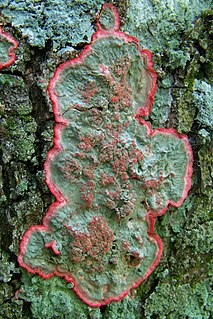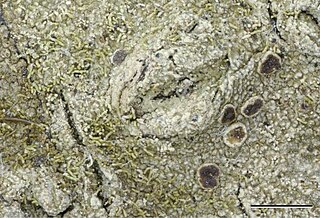
Cryptothecia is a genus of white to greenish crustose lichens that grow on bark, wood, or leaves. in tropical or subtropical areas worldwide. It has a conspicuous prothallus that develops around its periphery which can be bright red in some species, hence the common name wreath lichen. The main vegetative body (thallus) lacks a cortex (ecorticate and is often immersed in the substrate or byssoid. The medulla is white, well defined, and often peppered with calcium oxalate crystals. Ascomata are not well defined, being cushions of soft white mycelium immersed in the medullary tissue, hence the name from the Greek krypto = "to conceal" and theke = "a container or sheath". There are about 45 described species in the genus according to one source, and 75 species according to another. The genus is in the family Arthoniaceae. It contains Trentepohlia, a green alga, as its photobiont partner.

Astrothelium is a genus of corticolous (bark-dwelling) lichens in the family Trypetheliaceae.

Neoprotoparmelia is a genus of crustose lichens that was created in 2018. It contains 24 tropical and subtropical species that mostly grow on bark. Neoprotoparmelia is in the subfamily Protoparmelioideae of the family Parmeliaceae, along with the morphologically similar genera Protoparmelia and Maronina.
Cladonia inflata is a rare species of terricolous (ground-dwelling) lichen in the family Cladoniaceae. Found in Bahia, Brazil, it was formally described as a new species in 2018 by lichenologists André Aptroot and Marcela Eugenia da Silva Cáceres. The type specimen was collected by the authors from Palmeiras, on the Mount of Pai Inácio, at an altitude between 1,050 and 1,140 m ; here the lichen was found growing on siliceous sandstone rock in a transitional forest. Cladonia inflata is only known to occur at the type locality, and is only known from the type specimen. At this location the lichen is conspicuous but not abundant, and forms extensive mats with many other Cladonia species, such as C. bahiana, C. clathrata, C. dissecta, C. divaricata, C. friabilis, C. furfuracea, C. metaminiata, C. miniata, C. obscurata, C. parvipes, C. pityrophylla, C. polyscypha, C. salmonea, C. secundana, and C. substellata. The lichen has a fruticose (bushy), mineral-grey thallus that consists of upright hollow podetia measuring about 4 to 7 cm high, atop a cushion up to 10 cm (4 in) in diameter. It contains the secondary compound fumarprotocetraric acid. The specific epithet inflata refers to the inflated thallus of the lichen.
Cladonia lichexanthonica is a rare species of saxicolous (rock-dwelling) lichen in the family Cladoniaceae. Found in Bahia, Brazil, it was formally described as a new species in 2018 by lichenologists André Aptroot and Marcela Eugenia da Silva Cáceres. The type specimen was collected by the authors from the Morro do Pai Inácio at an altitude between 1,050 and 1,140 m ; here the lichen was found growing on siliceous sandstone rock in a transitional forest. Cladonia lichexanthonica is only known to occur at the type locality, and is only known from the type specimen. The lichen has a squamulose (scaley) thallus measuring up to 10 cm (4 in) in diameter; this consists of a 5-millimetre (0.2 in) thick crust comprising individual crowded squamules, pale-olive green to olive brown, measuring 1–5 mm in size. The specific epithet lichexanthonica refers to the presence of lichexanthone, a secondary compound that was not previously known to occur in genus Cladonia.
Pertusaria lichexanthoimmersa is a rare species of crustose and corticolous (bark-dwelling) lichen in the family Pertusariaceae. Found in Bahia, Brazil, it was formally described as a new species in 2018 by lichenologists André Aptroot and Marcela Eugenia da Silva Cáceres. The type specimen was collected by the authors from the Morro do Pai Inácio at an altitude between 1,050 and 1,140 m ; here the lichen was found growing on tree bark in a transitional forest. Pertusaria lichexanthoimmersa is only known to occur at the type locality, and is only known from the type specimen. The specific epithet lichexanthoimmersa refers both to the presence of lichexanthone as a secondary chemical, and the apothecia, which are immersed in the thallus. The lichen also contains norstictic acid.
Pertusaria lichexanthoverrucosa is a rare species of crustose and corticolous (bark-dwelling) lichen in the family Pertusariaceae. Found in Bahia, Brazil, it was formally described as a new species in 2018 by lichenologists André Aptroot and Marcela Eugenia da Silva Cáceres. The type specimen was collected by the authors near the Cachoeira do Mosquito at an altitude between 450 and 500 m ; here the lichen was found growing on tree bark in Atlantic Forest near a river. Pertusaria lichexanthoverrucosa is only known to occur at the type locality, which is part of the Chapada Diamantina mountains. The specific epithet lichexanthoverrucosa refers to both the presence of lichexanthone as well as the verrucose (warty) thallus.

Neoprotoparmelia amerisidiata is a species of corticolous and crustose lichen in the family Parmeliaceae. Found in the southeastern United States, it was formally described as a new species in 2018 by Garima Singh and André Aptroot. The type specimen was collected by James Lendemer in the Sapelo Island Wildlife Management Area ; here the lichen was found growing on oak bark. It has a thin, shiny, pale olive-green to olive-grey thallus with numerous isidia. Secondary chemicals in the lichen that are detectable with thin-layer chromatography include alectoronic acid (major), and lesser to trace amounts of dehydroalectoronic acid and β-alectoronic acid. The specific epithet amerisidiata refers to both its North American distribution and the presence of isidia. It is known from North Carolina, Alabama, Georgia, Mississippi, and Florida.

Neoprotoparmelia australisidiata is a species of areolate lichen in the family Parmeliaceae. Found in Australia, it was formally described as a new species in 2018 by Garima Singh and André Aptroot. The type specimen was collected by Gintaras Kantvilas north of Emerald Springs ; here it was found growing on the wood or bark of a Cooktown ironwood tree. The lichen has also been recorded in New South Wales. The specific epithet refers both to its Australian distribution, and the presence of isidia. Secondary chemicals in the lichen that are detectable with thin-layer chromatography include alectoronic acid (major), and minor to trace amounts of dehydroalectoronic acid and β–alectoronic acid.

Neoprotoparmelia capensis is a species of saxicolous (rock-dwelling), crustose lichen in the family Parmeliaceae. Found in South Africa, it was formally described as a new species in 2018 by Víctor Jiménez Rico, Ana Crespo, and Garima Singh. The type specimen was collected between Papendorp and Strandfontein ; the specific epithet refers to the province in which it was discovered. The lichen is only known from the type locality, a karoo biome with many succulent plants; it grows on exposed sandstone, forming thin, light grey to pale to strong brown and areolate crusts up to 8 cm (3 in) in diameter.

Neoprotoparmelia crassa is a species of crustose lichen in the family Parmeliaceae. Found in Australia, it was formally described as a new species in 2018 by Garima Singh and André Aptroot. The type specimen was collected by John Elix in Solar Village. It is only known to occur here and in Northern Territory, where it grows on the bark and wood of trees in open and closed forests. It contains alectoronic acid, a secondary chemical. The specific epithet crassa, derived from the Latin crassus ("fat") refers to the thickness of its thallus, which is greater than the other isidiate members of genus Neoprotoparmelia.

Neoprotoparmelia paulii is a species of saxicolous (rock-dwelling), crustose lichen in the family Parmeliaceae. Found in Kenya, it was formally described as a new species in 2018 by Víctor Jiménez Rico, Helge Thorsten Lumbsch, and Garima Singh. The type specimen was collected in the Nuu Hills at an altitude of about 1,000 m (3,300 ft); here it was found growing on sandstone in an inselberg with dry woodland. The lichen is only known from the type locality, a montane ecosystem dominated by shrubs and trees from the genera Acacia, Combretum, and Terminalia. Neoprotoparmelia paulii contains several secondary compounds that can be detected using the technique thin-layer chromatography, including atranorin, α–collatolic acid, α–alectoronic acid, and traces of other chemically related substances. The specific epithet paulii honours Kenyan lichenologist Paul Kirika, who collected the type material along with Lumbsch.

Neoprotoparmelia plurisporibadia is a species of saxicolous (rock-dwelling), crustose lichen in the family Parmeliaceae. It is found in Rio Grande do Sul, Brazil, where it grows on granite rocks in low, open mountainous areas.

Neoprotoparmelia siamisidiata is a species of corticolous (bark-dwelling) and crustose lichen in the family Parmeliaceae. Found in Thailand, it was formally described as a new species in 2018 by Garima Singh and André Aptroot. The type specimen was collected by Harrie Sipman in the Medicinal Garden of Doi Suthep–Pui National Park at an altitude of about 1,100 m (3,600 ft); here it was found growing on the bark of Cinchona pubescens. The specific epithet refers to its type locality (biology) and the presence of isidia.
Neoprotoparmelia capitata is a species of corticolous (bark-dwelling) and crustose lichen in the family Parmeliaceae. It is found in eastern North America.
Acanthothecis norstictica is a species of corticolous (bark-dwelling) lichen in the family Graphidaceae. Found in Brazil, it was formally described as a new species in 2022 by André Aptroot, Robert Lücking, and Marcela Eugenia da Silva Cáceres. The type specimen was collected from a farm near Itaguatins (Tocantins), where it was found growing on tree bark in cerrado. The lichen contains norstictic acid, the presence of which is referred to in the specific epithet norstictica.
Acanthothecis rimosa is a species of corticolous (bark-dwelling) lichen in the family Graphidaceae. Found in Brazil, it was formally described as a new species in 2022 by André Aptroot, Robert Lücking, and Marcela Eugenia da Silva Cáceres. The type specimen was collected from the Pedra Talhada private area in Quebrangulo (Alagoas) at an elevation between 500 and 700 m. The lichen has a smooth and somewhat shiny, mineral-grey thallus lacking a cortex, and also lacking a surrounding prothallus. The asci contain two spores. The ascospores are hyaline, ellipsoid, and measure 45–53 by 13–16 μm; they have 15–19 transverse and 3–4 longitudinal septa. Stictic acid, a lichen product, is found in the lichen and is detectable using thin-layer chromatography.
Acanthothecis saxicola is a species of saxicolous (rock-dwelling) lichen in the family Graphidaceae. Found in Brazil, it was formally described as a new species in 2022 by André Aptroot, Robert Lücking, and Marcela Eugenia da Silva M.Cáceres. The type specimen was collected near Poço Azul at an altitude of 450 m (1,480 ft); here, in a cerrado forest, it was found growing on an overhanging sandstone. The lichen has an ochraceous white thallus lacking a cortex and a prothallus. Its asci contains eight spores, and the ascospores are hyaline, measuring 22–30 by 5 μm with 6 to 8 transverse septa. Acanthothecis saxicola contains stictic acid, a lichen product detectable using thin-layer chromatography.
Diorygma incantatum is a species of corticolous (bark-dwelling) crustose lichen in the family Graphidaceae. It is found in northern and southern Brazil.
Diorygma pauciseptatum is a species of corticolous (bark-dwelling) lichen in the family Graphidaceae. Found in Brazil, it was formally described as new to science in 2014 as a collaborative effort by several lichenologists: Shirley Feuerstein, Iane Cunha, André Aptroot, and Marcela Cáceres. The type specimen was collected by the first author from Fazenda São Paulo, where it was found growing on tree bark. The lichen has an opaque, irregular, yellowish-green thallus that lacks soredia and isidia. It is characterised from other Diorygma species by its ascospores, which measure 28–32 by 7 μm and have from 7 to 9 transverse septa; this species has ascospores with the fewest septa in the genus. Additionally, this species contains norstictic and connorstictic acids, which are lichen products that can be detected using thin-layer chromatography.










